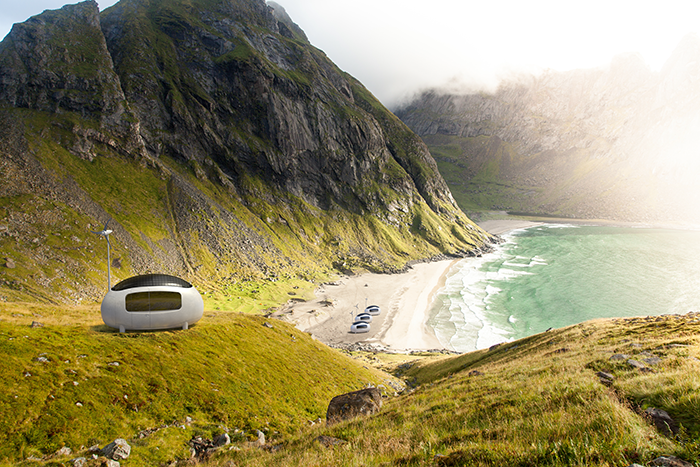Micro dwelling

|
| This micro dwelling is an Ecocapsule; a smart, self-sustainable micro-home that can be placed anywhere. |
Contents |
[edit] Introduction
Micro dwellings are single residential units that tend to range from 14 to 46 square metres. They can be built a foundations or other platforms or sometimes on wheels and typically have living quarters (kitchen, bathroom, sleeping accommodations), utilities (water, electricity, sewer connections) and are suitable for full time occupancy.
[edit] Background
Micro dwellings fall into a general category of residential living associated with the small house movement. They are referred to by different names, including micro apartments, micro homes, micro units, tiny homes, tiny houses and so on.
Restricted residential quarters have been in existence for centuries. In modern times, motorhomes were introduced in the early 1900s. Some people saw motorhomes as a way to travel with a greater degree of flexibility, as they had accommodation available anytime and anywhere.
In post-World War II America, new homes (such as those in the Levittown housing developments) were built to a modest scale with roughly 70 square metres of living space. However, that trend changed in the 1960s with the growth of the suburbs and migration away from the restrictions associated with city living.
In the 1970s, the modern small house movement emerged in contrast to suburban migration. It was seen as a permanent residential option that was particularly appealing to minimalist advocates who supported efforts to streamline lifestyles and improve housing affordability.
[edit] Growing popularity
The micro dwelling concept continued to gain popularity as an architectural and social movement in the 1990s for several reasons, including global economic instability, environmental concerns, increasing urban housing prices, lack of space and technological innovation. It has continued to gain momentum for people who are looking for affordable housing options due to financial limitations (such as living on a fixed income), personal hardship (such as homelessness) or other personal reasons (such as connecting with their families).
Maintaining a micro dwelling may also provide tax advantages while lowering utility bills and maintenance costs associated with traditional homes. This may be beneficial for people who lack the savings required for standard home upkeep costs.
[edit] International regulations
Unlike motorhomes, micro dwellings on wheels are permanent residences. Whether they are built on wheels or on foundations, they are meant to last as long as a traditional home and often use standard building techniques and materials.
In August 2017, the International Code Council (ICC) published its 2018 International Residential Code (IRC), which included Appendix Q Tiny Houses. This standard specifies various requirements (such as ceiling heights, stairways, lofts, emergency escape and so on) as they apply to single dwelling units that are 400 square feet (37 square metres) or less - excluding the loft space. This standard is applied in some US cities where micro dwellings are becoming increasingly popular.
[edit] Micro dwellings in the UK
UK micro dwellings are designed and built to comply with UK building regulations and planning permission requirements.
With wheel-based micro units, there are several additional considerations, particularly if the intention is to maintain their mobility features. Micro dwelling owners who wish to transport their homes must comply with UK caravan law restrictions regarding width, length and weight of the home. They may also wish to apply for a suitable driving licence if they plan to travel with the home frequently.
Some owners may wish to place their homes on land they already occupy, which may possible without planning permission under permitted development regulations as long as the micro dwelling is within a certain size and situation.
[edit] Related articles on Designing Buildings
- Affordable housing.
- Anchorhold.
- Building regulations.
- Could microhousing tackle London's housing crisis?
- Home ownership.
- Levittown.
- Megacity.
- Micro flats.
- Planning permission.
- Pocket homes.
- Smallest house in Britain.
- Suburb.
- Urban design.
[edit] External resources
Featured articles and news
Gregor Harvie argues that AI is state-sanctioned theft of IP.
Many resources for visitors aswell as new features for members.
Using technology to empower communities
The Community data platform; capturing the DNA of a place and fostering participation, for better design.
Heat pump and wind turbine sound calculations for PDRs
MCS publish updated sound calculation standards for permitted development installations.
Homes England creates largest housing-led site in the North
Successful, 34 hectare land acquisition with the residential allocation now completed.
Scottish apprenticeship training proposals
General support although better accountability and transparency is sought.
The history of building regulations
A story of belated action in response to crisis.
Moisture, fire safety and emerging trends in living walls
How wet is your wall?
Current policy explained and newly published consultation by the UK and Welsh Governments.
British architecture 1919–39. Book review.
Conservation of listed prefabs in Moseley.
Energy industry calls for urgent reform.
Heritage staff wellbeing at work survey.
A five minute introduction.
50th Golden anniversary ECA Edmundson apprentice award
Showcasing the very best electrotechnical and engineering services for half a century.
Welsh government consults on HRBs and reg changes
Seeking feedback on a new regulatory regime and a broad range of issues.
CIOB Client Guide (2nd edition) March 2025
Free download covering statutory dutyholder roles under the Building Safety Act and much more.























